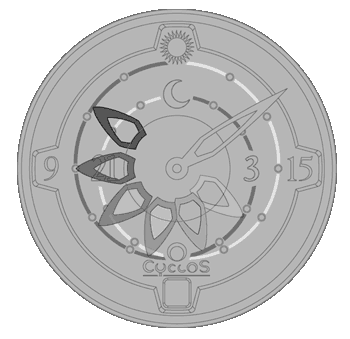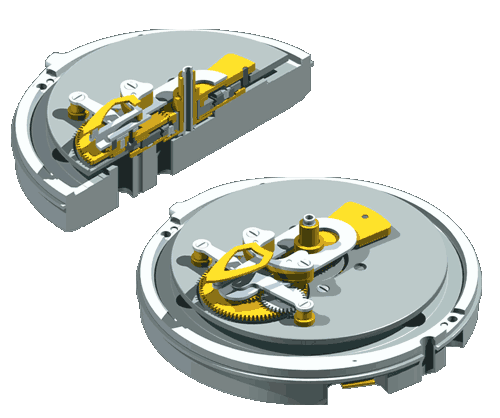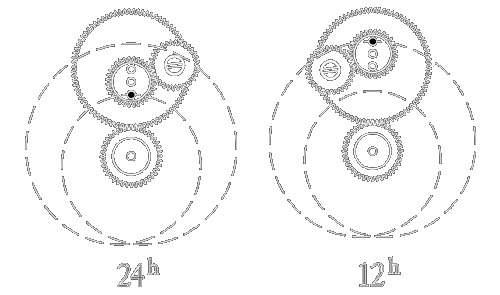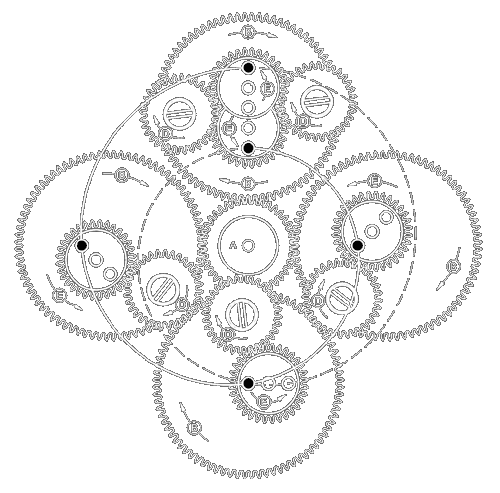 |
|
 |
|
|
|
|
|
|
IDEA AND ITS HISTORY
The idea for CYCLOS arose from the
unsatisfying double meaning of the
usual 12-hour scale. Every point
on the scale designates
both the day’s cycle and that of the night, without being
able to differentiate between them. In the English speaking
world one adds "ante meridian” or "post meridian” in
order to make the distinction clear. The well known 24-hour
clock, on which the hours are all ordered in one circle, has
the disadvantage that one has to change ones perception of the
angles of the hand in order to read the time.
In 1989 the architect and designer John
C. Ermel, working on an order for a new watch design, had
the
idea of making the
difference between the cycles of day and night obvious.
This could be achieved by using a radially adjustable hour
hand. He arranged the scale of hours on a so-called "Pascal’s
spiral”, a conchoid of a circle, a special cycloid
achieved by overlapping the usual clockwise rotation with
translation in the radial direction – in this case
a sine curve with a cycle of 24 hours.
See Animation
|

|
|
The mechanism necessary for controlling such an hour hand took more than 10 years to develop and is a real marvel of Swiss watchmaking craftsmanship. In 1999 John C. Ermel applied for a Swiss patent on his idea, in 2000 for a worldwide patent. The clearest way of seeing how the system works is with the aid of the following illustrations:
|

|
The CYCLOS DualPhase module
The
visible hour hand is mounted on a finger, which is attached
to a radially adjustable arm beneath the dial. In the cutaway
view the gilded brass gearwheels A, B, C and E are visible
underneath the arm (light-gray). The dark-grey pin in the
left foreground located in gearwheel E guiding the arm is
the guide pin F.
|
 |
The gearwheels A, B, D and E at 12h midnight
and at 12h noon
The dark-grey point indicates the guide pin F and the broken
curve shows the Pascal spiral.
|

|
Simultaneous representation
of 5 positions of the gearwheels A, B, D and E, namely at 24h/0h,
3h, 6h, 9h and 12h, which is synonymous with "ante
meridian". Gearwheel A in the centre remains fixed, gearwheel
B is twice as large and turns around A once every 12 hours and
rotates 540° around itself during the same time period.
Gearwheels D and E are mounted on bearings on B so that they
can rotate and, in conjunction with other hidden gearwheels,
correct the parallel axis. The Pascal spiral, which can be described
mathematically by the formula ΔRf
= ra + rb ± 2rf cos[(φ
- 90)/2] , is formed in this way. In this formula
ΔRf represents the variable distance of the
guide pin F from the centre, ra = radius of gearwheel
A, rb = radius of gearwheel B (whereby rb
= 2ra), rf = distance of the guide pin
F from the centre of gearwheel E.
The two initially available collections indicate two phases
in the course of the 24-hour day in different ways:
- on the sporty "a.m./p.m." models,
the hourly scale is formed by an outwardly winding spiral
in red which indicates the hours "ante meridian",
and an inwardly winding spiral in blue which indicates
the
hours "post meridian". The two phases are separated
at 12 noon / midnight.
- on the elegant "day & night"
models, one sees an outer loop in gold which indicates
the daytime hours, and an inner loop in white or silver
which indicates
the nighttime hours. Here, the two phases are separated
from each other at 6h/18h.
 Download pdf-document IDEA
AND ITS HISTORY [228
KB]
Download pdf-document IDEA
AND ITS HISTORY [228
KB]
|
|
|





